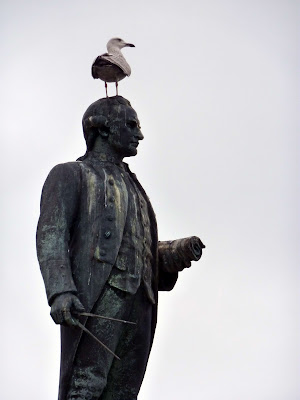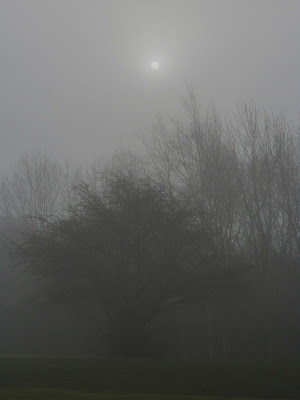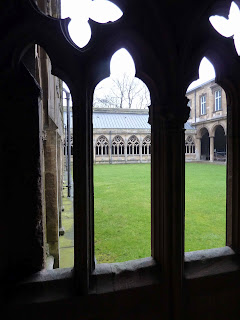I hope everyone has had a successful week? Well, I spoke too soon on my last blog - a grey cold spring has returned to these shores and we had a fog last week that was just two degrees Celsius which was close to being a hoar frost and damaging the newly forming buds.
 |
| One of the many keen and vociferous Gulls on the harbour side | | |
Anyway, I digress. Today's blog is about a recent visit to the seaside town and port of Whitby in North Yorkshire. I like to keep you in touch with where I visit with a few simple pictures. I don't get much spare time other than organised holidays so a day in Whitby was a lovely break despite it being cold, grey and raw. Walking around the town kept me warm enough however and stops at friendly cafes and shops kept me warm at regular intervals. The name Whitby comes from old Norse - 'Witebi' which means white settlement.
Now there are several bloggers who know Whitby well, one who lives there and a couple of others who live nearby so I hope I do it justice. I set off early, about 1 hour 45 minutes of driving along decent roads and got there at 10 am and parked in the West Cliff car park which is quite high up on the towns north side. Now one thing you need to know about Whitby is that it's surrounded by hills which form a sort of valley for the River Esk which goes into the North Sea at this point and the older town surrounds it. If you have difficulty walking, planning your journey, parking and access the various sites is wise. But whatever you do, don't let this put you off, it is well worth every effort of planning.
 |
| Looking down on the River Esk |
There weren't too many people about other than the locals and workers along the Riverside and strangely several school groups ranging from very young primary school children to French students. Perhaps the chill day kept some people at home in front of the fire. I browsed the shops and cafes both sides of the Esk, and crossed over it by a road bridge. To get to the famous Abbey, from the harbour, you can climb a long way up steps (please do this only if you are fit enough) or you can drive to the Abbey which I chose to do (coward - although I did manage to climb up to the West Cliff car park without much difficulty which I was rather pleased with.)
There's a variety of touristy type shops: souvenirs, Whitby Jet (a dark black precious stone which is made into jewelry), Gothic and other more 'normal' shops. There's plenty of eating places, including harbour side fish and chip shops, but we chose the wrong place and had a very expensive and very ordinary chicken salad.
There is miles of lovely beach to walk along and a harbour to meander along but I managed to stay off the beach - it was just too cold and I didn't have the right footwear.
 |
| Whitby Abbey |
After a few hours wandering round this pleasant part of the old town, I drove up to the Abbey only to discover, having paid £2 parking fee that the Abbey was shut on weekdays and I couldn't get in which was a disappointment. The silly thing is that there were dozens of people in the same boat, equally as disappointed, so English Heritage would have still made a few quid even thought the weather was cold.
St Mary's Church is next door and I had a wander round the graveyard and the badly weathered sandstone gravestones before setting off for home.
I last went to Whitby as a kid with a school trip and remember spending most of the day playing footy with my mates on the beach. I enjoyed the town and thoroughly recommend it as a day out. Whitby is surrounded by beautiful countryside and has good rail access.
I won't bore you with the history of the town, you can check Wikipedia and other sites for the detail, but this place was inspiration for Bram Stoker to use as the landing place for Count Dracula. The Abbey ruins cast a spectacular and moody shadow over the harbour and on the day I visited, the cold damp weather just increases the atmosphere. There is a regular Goth Festival where people go and visit dressed up in Gothic costume - highly entertaining pictures can be found all over the net and one day I will visit when the festival is on.

Famous sons of Whitby include Frank Sutcliffe a photographer who captured the life of the town in the late Victorian age and whose photographs are revered even today. Captain James Cook (left - with friend) did his apprenticeship on coal colliers out of the port and by coincidence, the ship which was eventually to be renamed as HMS Endeavour which Cook sailed around to the other side of the world was built in Whitby in 1764.
There was a monastery founded as long ago as AD 657 upon which site the later Abbey now stands albeit in ruins.
A number of famous authors visited the town and perhaps got inspiration there: Charles Dickens, Bram Stoker, Elizabeth Gaskell, Lewis Carroll and Wilkie Collins.
A lovely day despite the weather - I am now determined to revisit in warmer conditions!
An extract from Mina Murray's Journal from Bram Stoker's 1897 novel Dracula, she describes Whitby shortly after her arrival:
This is a lovely
place. The little river, the Esk, runs through a deep valley, which broadens out as it comes near the harbour. A great
viaduct runs across, with high piers, through which the view
seems somehow further away than it really is. The valley is
beautifully green, and it is so steep that when you are on
the high land on either side you look right across it, unless you are near enough to see down. The houses of the old
town--the side away from us, are all red-roofed, and seem
piled up one over the other anyhow, like the pictures we see
of Nuremberg. Right over the town is the ruin of Whitby Abbey, which was sacked by the Danes, and which is the scene of
part of "Marmion," where the girl was built up in the wall.
It is a most noble ruin, of immense size, and full of beautiful and romantic bits. There is a legend that a white lady
is seen in one of the windows. Between it and the town there
is another church, the parish one, round which is a big
graveyard, all full of tombstones. This is to my mind the
nicest spot in Whitby, for it lies right over the town, and
has a full view of the harbour and all up the bay to where
the headland called Kettleness stretches out into the sea.It
descends so steeply over the harbour that part of the bank
has fallen away, and some of the graves have been destroyed.
Chat soon
Ta-ra
 Spring is well and truly here and whilst its not set to last with normal temperature returning by the weekend, most of the UK is basking in sun under a high pressure system which is reluctant to clear away. By day temperatures are reaching 20 degrees but by night, fogs appear and this morning, the cars were covered in frost. It's difficult to forget its only March.
Spring is well and truly here and whilst its not set to last with normal temperature returning by the weekend, most of the UK is basking in sun under a high pressure system which is reluctant to clear away. By day temperatures are reaching 20 degrees but by night, fogs appear and this morning, the cars were covered in frost. It's difficult to forget its only March.























